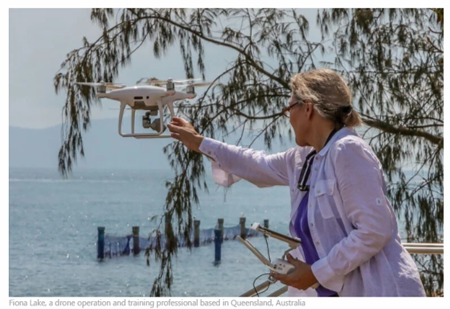K
Kathleen Martin
Guest
How can farmers increase the value of existing technology – and stay safe while using it?
Is your drone paying for itself? Are you using it safely? Did you potentially bite off more than you could metaphorically chew?
In Future Farming’s latest Field Trials podcast, Fiona Lake, a drone operation and training professional based in Queensland, Australia, discusses drone utility, the role creativity plays in making the technology pay, uses for other ag-tech tools, and much more besides.
Many applications
From Lake’s perspective, drones have the potential to play a significantly larger role in Australian agriculture than is being currently realized. This is particularly true as costs for the equipment continue to drop, and those employing the technology get more creative in its use.
Thermal imaging is one area Lake finds exciting for both crop and livestock sectors. Tasks as simple as checking hay stocks for potential fire-indicating temperature anomalies – an idea posed by a farmer attending one of Lake’s drone training workshops – can save enormous amounts of time and money.
Training in level two thermography certification, she says, is vital if accurate temperature measurement is required, while level one certification is recommended for the most accurate temperature comparison mapping. Like any technology, though, Lake adds thermal imaging has its limitations. Finding livestock or objects buried under snow is one thing, but trying to identify something in the hot Australian outback is another challenge altogether.
Additional lower-level hardware such as water or livestock sensors, temperature probes, and cameras can similarly bring significant risk reduction. In reference to a wider argument, however, Lake wonders whether technology as basic as fire alarms are used often enough.
Read more and listen in: https://www.futurefarming.com/tech-in-focus/drones/field-trials-podcast-getting-creative-with-drone-use/
Is your drone paying for itself? Are you using it safely? Did you potentially bite off more than you could metaphorically chew?
In Future Farming’s latest Field Trials podcast, Fiona Lake, a drone operation and training professional based in Queensland, Australia, discusses drone utility, the role creativity plays in making the technology pay, uses for other ag-tech tools, and much more besides.
Many applications
From Lake’s perspective, drones have the potential to play a significantly larger role in Australian agriculture than is being currently realized. This is particularly true as costs for the equipment continue to drop, and those employing the technology get more creative in its use.
Thermal imaging is one area Lake finds exciting for both crop and livestock sectors. Tasks as simple as checking hay stocks for potential fire-indicating temperature anomalies – an idea posed by a farmer attending one of Lake’s drone training workshops – can save enormous amounts of time and money.
Training in level two thermography certification, she says, is vital if accurate temperature measurement is required, while level one certification is recommended for the most accurate temperature comparison mapping. Like any technology, though, Lake adds thermal imaging has its limitations. Finding livestock or objects buried under snow is one thing, but trying to identify something in the hot Australian outback is another challenge altogether.
Additional lower-level hardware such as water or livestock sensors, temperature probes, and cameras can similarly bring significant risk reduction. In reference to a wider argument, however, Lake wonders whether technology as basic as fire alarms are used often enough.
The thing with ag-tech, what’s also underestimated is the mental health benefits…You find problems early and then you can relax more. If you have tools which can find problems early and put your mind at ease, that’s priceless, and it will make you do a better job of running a business.
Read more and listen in: https://www.futurefarming.com/tech-in-focus/drones/field-trials-podcast-getting-creative-with-drone-use/

